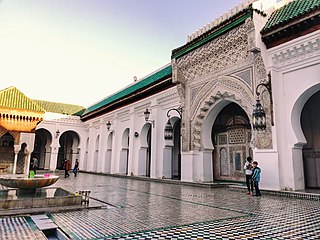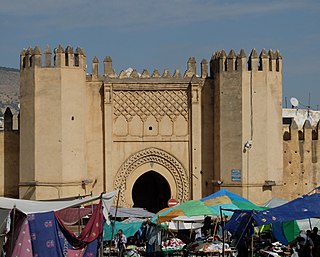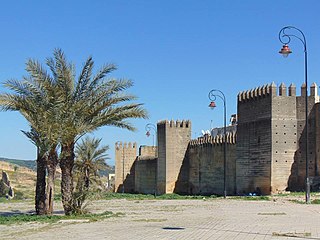
Moroccan architecture reflects Morocco's diverse geography and long history, marked by successive waves of settlers through both migration and military conquest. This architectural heritage includes ancient Roman sites, historic Islamic architecture, local vernacular architecture, 20th-century French colonial architecture, and modern architecture.

Fes el Bali is the oldest walled part of Fez, the second largest city of Morocco. Fes el Bali was founded as the capital of the Idrisid dynasty between 789 and 808 AD. UNESCO listed Fes el Bali, along with Fes Jdid, as a World Heritage Site in 1981 under the name Medina of Fez. The World Heritage Site includes Fes el Bali's urban fabric and walls as well as a buffer zone outside of the walls that is intended to preserve the visual integrity of the location. Fes el Bali is, along with Fes Jdid and the French-created Ville Nouvelle or “New Town”, one of the three main districts in Fez.

Fes Jdid or Fes el-Jdid is one of the three parts of Fez, the second largest city of Morocco. It was founded by the Marinids in 1276 as an extension of Fes el Bali and as a royal citadel and capital. It is occupied in large part by the historic Royal Palace, which was once the center of government in Morocco and which is still used on occasion by the King of Morocco today. The district also contains the historic Mellah of the city. Since 1981 it has been classified, along with Fes el-Bali, as a UNESCO World Heritage Site.

Fes or Fez is a city in northern inland Morocco and the capital of the Fez-Meknes administrative region. It is one of the largest cities in Morocco, with a population of 1.256 million, according to the 2024 census. Located to the northwest of the Atlas Mountains, it is surrounded by hills and the old city is centered around the Fez River flowing from west to east. Fez has been called the "Mecca of the West" and the "Athens of Africa". It is also considered the spiritual and cultural capital of Morocco.

Bab Bou Jeloud is an ornate city gate in Fes el Bali, the old city of Fez, Morocco. The current gate was built by the French colonial administration in 1913 to serve as the grand entrance to the old city.

The Kasbah An-Nouar or Kasbah Filali is a walled district and former military enclosure in the old medina of Fez, Morocco. Its name means "citadel of the flowers", but it is sometimes also referred to as Kasbah Filala and Kasbah Chorfa. It is one of several fortified military enclosures or kasbahs that were built around the old city of Fez across different periods.

Chouara Tannery is one of the three tanneries in the city of Fez, Morocco. It is the largest tannery in the city and one of the oldest. It is located in Fes el Bali, the oldest medina quarter of the city, near the Saffarin Madrasa along the Oued Fes. Since the inception of the city, the tanning industry has been continually operating in the same fashion as it did in the early centuries. Today, the tanning industry in the city is considered one of the main tourist attractions. The tanneries are packed with round stone vessels filled with dye or white liquids for softening the hides. The leather goods produced in the tanneries are exported around the world.

Dar Batḥa, or Qasr al-Batḥa, is a former royal palace in the city of Fez, Morocco. The palace was commissioned by the Alaouite Sultan Hassan I in the late 19th century and finished under his successor Abdelaziz. It was converted into a museum of historical arts and crafts in 1915 with a collection that now comprises over 6,500 objects. The palace is located near Bab Bou Jeloud at the western edge of Fes el-Bali, the old medina quarter of the city, and close to Fes el-Jdid, the new medina quarter. It is adjacent to the Dar el-Beida palace located to its southeast, which was originally part of the same complex.

The Royal Palace or Dar al-Makhzen is the palace of the King of Morocco in the city of Fez, Morocco. Its original foundation dates back to the foundation of Fes el-Jdid, the royal citadel of the Marinid dynasty, in 1276 CE. Most of the palace today dates from the 'Alawi era. The vast grounds are home to multiple private structures, patios, and gardens, but historically also included administrative offices and government tribunals. Today, the most publicly visible parts of the palace are its main entrances at the Old Mechouar and the highly ornate 20th-century gates at Place des Alaouites, near the Mellah.

The R'cif Mosque is a Friday mosque in Fes el-Bali, the old city (medina) of Fez, Morocco. It has one of the tallest minarets in the city and overlooks Place R'cif in the heart of the medina.

The Fortifications of Fez comprise a complex circuit of ramparts and gates surrounding Fes el-Bali and Fes el-Jdid, two urban agglomerations that compose the old "medina" of Fes, Morocco. They also include a number of kasbahs (citadels) and forts which were built both to protect and to control the city. These fortifications have been built up over many centuries and the extensive remnants today date from many different periods.

The architecture of Fez, Morocco, reflects the wider trends of Moroccan architecture dating from the city's foundation in the late 8th century and up to modern times. The old city (medina) of Fes, consisting of Fes el-Bali and Fes el-Jdid, is notable for being an exceptionally well-preserved medieval North African city and is classified as a UNESCO World Heritage Site. A large number of historic monuments from different periods still exist in it today, including mosques, madrasas, synagogues, hammams (bathhouses), souqs (markets), funduqs (caravanserais), defensive walls, city gates, historic houses, and palaces.

Bab Guissa or Bab Gisa is the main northwestern gate of Fes el Bali, the old walled city of Fes, Morocco.

The Jnan Sbil Gardens, also known as the Bou Jeloud Gardens, is public garden in Fez, Morocco, located between Fes el-Jdid and Fes el-Bali, the two sections of the old medina.

Bab Dekkakin or Bab Dekakene is a fortified and ceremonial gate in Fes, Morocco. The gate is situated between the Old Mechouar and the New Mechouar on the northern edge of Fes el-Jdid.

The Mosara Garden or el-Mosara was a vast royal garden to the north of Fes el-Jdid, the historic citadel and palace-city of the Marinid dynasty in Fes, Morocco. The gardens were created by the Marinid sultan Abu Ya'qub Yusuf in 1286 and became famous in part because of a huge noria (waterwheel) that was created to provide it with water. The gardens were abandoned and progressively ruined during the Saadian period and have since disappeared, leaving only traces in a few structures such as Bab Segma.

The Mellah of Fez is the historic Jewish quarter (Mellah) of Fez, Morocco. It is located in Fes el-Jdid, the part of Fez which contains the Royal Palace, and is believed to date from the mid-15th century. While the district is no longer home to any significant Jewish population, it still contains a number of monuments and landmarks from the Jewish community's historical heritage in the city.

The Walls of Marrakesh are a set of defensive ramparts which enclose the historic medina districts of Marrakesh, Morocco. They were first laid out in the early 12th century by the Almoravid dynasty which founded the city in 1070 CE as their new capital. The walls have since been expanded several times by the addition of the Kasbah to the south at the end of the 12th century and by a later extension to encompass the northern neighbourhood around the Zawiya of Sidi Bel Abbes.

The Sidi Moussa Tannery or Guerniz Tannery is a historic tanning facility located in the heart of Fes el-Bali, the historic medina of Fez, Morocco. The tannery is located in the Guerniz neighbourhood, near the Zawiya of Moulay Idris II and the Nejjarine Museum.

The History of Fez begins with its foundation by Idris I and Idris II at the end of the 8th century and the beginning of the 9th century CE. It initially consisted of two autonomous and competing settlements on opposing shores of what is now known as the Oued Fes. Initially inhabited by a largely Berber (Amazigh) population, successive waves of mainly Arab immigrants from Ifriqiya (Tunisia) and al-Andalus (Spain/Portugal) over time gave the nascent city an Arab character as well. After the downfall of the Idrisid dynasty, it was contested between different Zenata groups allied with either the Fatimid Caliphate or the Umayyad Caliphate of Cordoba. In the 11th century the Almoravid sultan Yusuf ibn Tashfin conquered the region and united its two settlements into what is today the Fes el-Bali quarter. Under the rule of the Almoravids and of the Almohads after them, despite losing the status of capital to Marrakesh, the city remained the economic and political center of northern Morocco and gained a reputation for religious scholarship and mercantile activity.






























